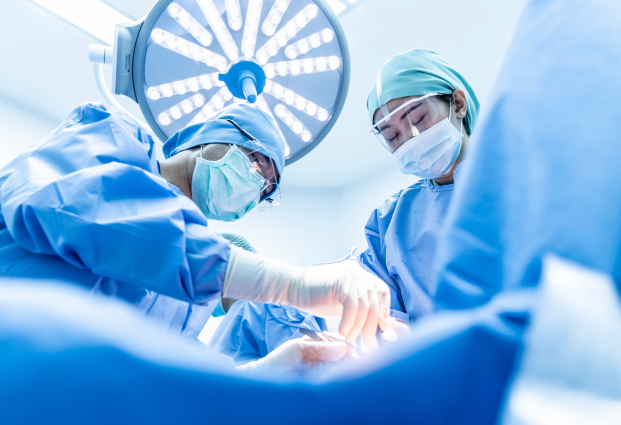Symptoms:
- Abdominal Pain: Initially, pain often begins around the navel and then intensifies and shifts to the lower right abdomen.
- Tenderness: Pressing on the lower right abdomen may cause increased pain and tenderness.
- Nausea and Vomiting: Many individuals with appendicitis experience nausea and may vomit.
- Loss of Appetite: A diminished desire to eat is a common symptom.
- Fever: An elevated body temperature may accompany appendicitis, indicating infection.
- Change in Bowel Habits: Some people may experience changes in bowel movements, including constipation or diarrhea.
Prevention:
- Maintain Good Hygiene: Practicing proper hygiene, including regular handwashing, can help prevent infections that may contribute to appendicitis.
- Fiber-Rich Diet: Consuming a diet high in fiber may promote regular bowel movements, potentially reducing the risk of blockages.
- Stay Hydrated: Drinking an adequate amount of water supports overall digestive health.
Treatment:
- Appendectomy: Surgical removal of the inflamed appendix is the primary treatment for appendicitis.
- Antibiotics: In some cases, antibiotics may be administered before surgery to treat infection or in situations where surgery is delayed.
- Pain Management: Medications such as analgesics are used to alleviate pain and discomfort.
- Intravenous (IV) Fluids: Hydration through IV fluids may be necessary, especially if vomiting or dehydration has occurred.
- Observation: In certain cases, a healthcare professional may opt for a period of observation to determine the severity and progression of symptoms before deciding on surgical intervention.
Appendicitis, a condition marked by inflammation of the appendix, is a medical emergency demanding swift attention. The appendix, a small, finger-shaped organ located in the lower right abdomen, can become obstructed or infected, leading to pain and tenderness. Classic symptoms include abdominal pain starting near the navel and migrating to the lower right side, accompanied by nausea, vomiting, and a loss of appetite. If left untreated, appendicitis may progress to a rupture, risking severe complications.
Symptoms:
- Abdominal Pain: Sharp pain in the upper right abdomen that may radiate to the back or right shoulder.
- Nausea and Vomiting: Gallstones can cause nausea and may lead to episodes of vomiting.
- Jaundice: Yellowing of the skin and eyes due to the obstruction of the bile duct by gallstones.
- Fever and Chills: Infection of the gallbladder, a complication of gallstones, may result in fever and chills.
- Changes in Stool and Urine Color: Light-colored stool and dark urine can occur due to disruptions in bile flow.
Prevention:
- Healthy Diet: Maintaining a diet low in saturated fats and cholesterol may reduce the risk of gallstones.
- Weight Management: Gradual and steady weight loss, if needed, can lower the risk of gallstone formation.
- Regular Physical Activity: Staying physically active supports overall health and may help prevent gallstones.
- Adequate Hydration: Drinking enough water is important for preventing the buildup of substances that can contribute to gallstone formation.
Treatment:
- Lifestyle Modifications: Dietary changes, weight management, and increased physical activity may be recommended to manage symptoms and prevent further gallstone formation.
- Medications: Certain medications may be prescribed to dissolve gallstones, but this approach is typically reserved for specific cases.
- Gallbladder Removal (Cholecystectomy): Surgical removal of the gallbladder is a common and effective treatment, often done using minimally invasive techniques.
- Extracorporeal Shock Wave Lithotripsy (ESWL): This non-invasive procedure uses shock waves to break up gallstones, allowing them to be passed naturally.
- Endoscopic Retrograde Cholangiopancreatography (ERCP): In some cases, an endoscope is used to remove gallstones from the bile duct or to place a stent for improved bile flow.
Gallstones, small, solid particles that form in the gallbladder, are a common medical issue affecting the digestive system. These stones develop when substances like cholesterol or bilirubin harden, causing varying degrees of discomfort and potential complications. Gallstones can range in size and may remain asymptomatic or lead to intense abdominal pain, nausea, and other digestive disturbances. Factors such as diet, weight, and genetics play a role in their formation.
Symptoms:
- Visible Bulge: A noticeable protrusion, often in the abdomen or groin area, indicating the presence of tissue pushing through a weakened area.
- Pain or Discomfort: Discomfort or aching at the site of the bulge, particularly when lifting or straining.
- Tenderness: The affected area may be tender to the touch.
- Feeling of Heaviness: Sensation of pressure or heaviness in the affected area, especially after prolonged standing or lifting.
- Changes in Bowel Movements: In some cases, hernias can cause constipation or other changes in bowel habits.
Prevention:
- Maintain a Healthy Weight: Obesity increases the risk of hernias, so maintaining a healthy weight through diet and exercise is crucial.
- Proper Lifting Technique: Lift heavy objects using proper technique, bending at the knees and not the waist, to avoid straining the abdominal muscles.
- Avoid Straining During Bowel Movements: Straining during bowel movements can contribute to the development of hernias; a diet rich in fiber can help prevent constipation.
- Quit Smoking: Smoking can weaken tissues and increase the risk of hernias; quitting smoking is beneficial for overall health.
Treatment:
- Hernia Truss: A supportive device that may help manage symptoms by providing external support to the hernia, but it does not cure the condition.
- Lifestyle Modifications: Avoiding activities that worsen symptoms, such as heavy lifting, and making dietary changes to prevent constipation.
- Surgery (Herniorrhaphy or Hernioplasty): Surgical repair is often recommended, involving the repositioning of protruding tissue and reinforcement of the weakened abdominal wall.
- Laparoscopic Repair: Minimally invasive surgery where small incisions are made, and a mesh is used to reinforce the weakened area.
- Open Repair: Traditional surgery with a larger incision, allowing the surgeon to manually reposition the herniated tissue and reinforce the area with a mesh if needed.
A hernia is a common medical condition characterized by the protrusion of an organ or tissue through a weakened area in the surrounding muscle or connective tissue. Typically presenting as a noticeable bulge, hernias can occur in various regions of the body, such as the abdomen or groin, and often result from increased pressure on weakened muscles. Common causes include heavy lifting, persistent coughing, or straining during bowel movements. While hernias may not always cause symptoms, discomfort, aching, or a visible bulge may occur, necessitating medical attention.













